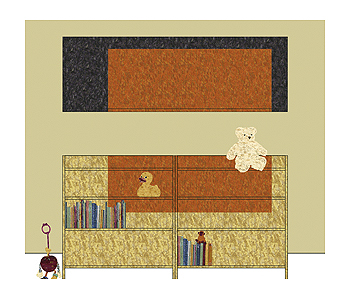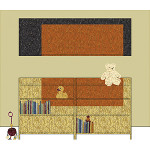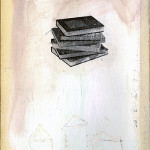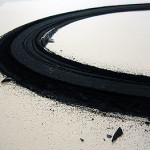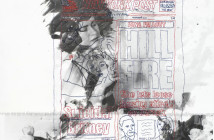5x5 is the fifth in a series of juried summer exhibitions that feature artists who live and/or work in Tufts University’s host communities. This year’s exhibition includes site-specific installations by five local artists: Kyle Larabee, Mindy Nierenberg, Roy Pardi, Randal Thurston, and August Ventimiglia. Although none of the works are site specific in that they would lose their meaning if removed from the gallery, two of them draw us into specific, well-composed environments: Larabee’s She Loves Me, She Loves Me Not and Nierenberg’s Bibliotheque Publicus: An Endangered Species.
Larabee’s two-room installation investigates the emotional impact of first-time fatherhood. The anteroom contains dozens of dried flowers, arranged neatly around the room in individual glass vases on shelves or collaged into works mounted on the walls. All have been stripped of their petals, suggesting that before his daughter’s birth, Larabee spoke “she loves me, she loves me not” to his unborn child over and over, never sure of the answer.
The petals that are absent from the anteroom are everywhere in the nursery: glued onto dressers, benches, and the crib; covering books and toys; collaged into “paintings” hung on the walls. The room’s predominant colors—shades of fuchsia, pink, yellow, and cream—are traditionally girlish, but the room is tightly controlled: one “painting” shows a landscape behind slim ivory bars, and the books on the shelves are carefully aligned along their spines. The crib itself, a white box with bars for railings, contains a petal-covered mattress but no bed linens. The only free-form elements in the room are the tendrils on the floor beneath the crib, which creep up its legs and railings. Does Larabee want to protect his daughter or to control her? This work, while perhaps most accessible to new fathers, may also offer insights to anyone raised by an overcontrolling parent, and might spark in more mature parents a recognition of their less experienced selves.
Nierenberg’s Bibliotheque Publicus has a broader audience: anyone who values free public access to books. Her installation is a scathing indictment of the funding cutbacks that threaten the existence of public libraries. Such reports appear regularly in newspapers and other sources; for example, this L.A. Times quotation that is incorporated into the work:
“The L.A. Public Library withered under budget cuts, and next year’s prospects are worse. The system has been unable to buy new books or renew its subscriptions. A proposed 1 dollar library-book fee is proposed [sic]to help the city cope with its staggering budget deficit, now tabulated at 406 million dollars. The fee, if adopted, would essentially destroy the cherished notion of a free public library...”
Nierenberg’s installation uses several physical elements to replicate the feel of a classic public library: a long library table, four Windsor-style chairs, and a wooden card catalogue. The lower trays of the catalogue, each of which holds a library-related quote, photograph, artwork, or other artifact, are accessible, but the upper trays are secured with padlocks, and a message posted atop the catalogue reads: “Unfortunately, the upper twelve drawers are CLOSED due to a 20% budget cut, so please do not touch them.” The most memorable elements of the installation, however, are the two 14’-high posters that tower over the table, each assembled from 1700+ card-catalogue cards and emblazoned in red ink with text. On one, we read reports about cutbacks, and on the other, quotations about the values of libraries. An entry by writer Ray Bradbury sums up Nierenberg’s message concisely: “Without libraries, what have we? We have no past and no future.”
The remaining three works are more personal explorations than environments. Ventimiglia’s Chalk Heat/Heat, based loosely on a running track on the Tufts campus, incorporates five small black-on-white charcoal ovals (Heat) and a large oval of white chalk on a grid of black rubber mats (Chalk Heat) “drawn” by the artist, who ran heats on the mats with white chalk embedded in his shoes. Ventimiglia views Chalk Heat as “a metaphor for the dual nature of the student athlete.” Thurston’s work The Pale Hours, another of his grand-scale black-paper silhouette installation, was inspired by Eastern European churches where skeletons appear as decorative elements, but Klee (Two Men Meet...) and Bosch (The Garden of Earthly Delights) have lent a hand: the escutcheons contain human bones, pairs of goateed men, butterflies, and frogs. Pardi’s Ring is an interactive light installation. In a dimly lit space, twenty-four light bulbs and sensors are suspended from a circular frame about 10’ wide. The lights cycle on and off in varying orders depending whether observers are in sensor range. If multiple observers are within range, the light sequences race, collide, and reverse in a complex set of sequences that are mathematically but not empirically predictable.
- Kyle Larabee, from the installation, She Loves Me/She Loves Me Not, installation, 2008
- Mindy Nierenberg, from the installation, Bibliotheca Publica: An Endangered Species, 2008
- August Ventimiglia, detail from, Heat (Series No. 3), compressed charcoal on paper, 2007
"Fifth Annual Juried Summer Exhibition
5x5 " is on view at Aidekman Arts Center, on Talbot Ave. on the Tufts University campus in Medford, MA.
All images are courtesy of the artists and Tufts University Art Gallery.

